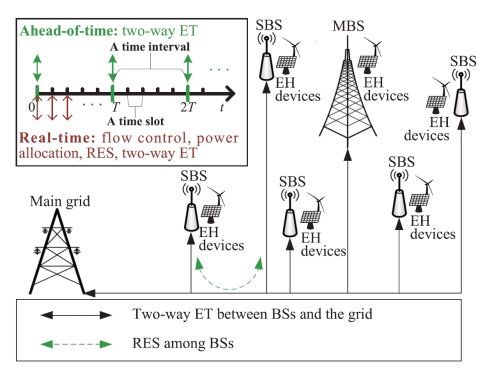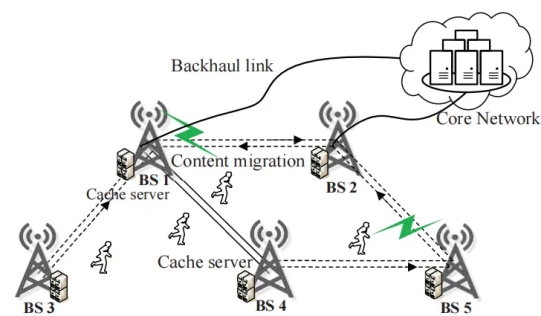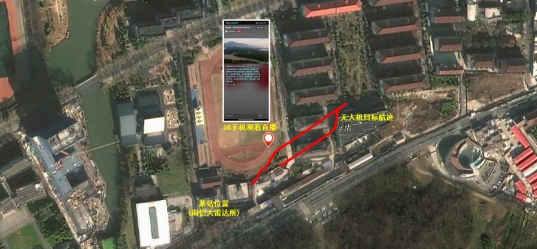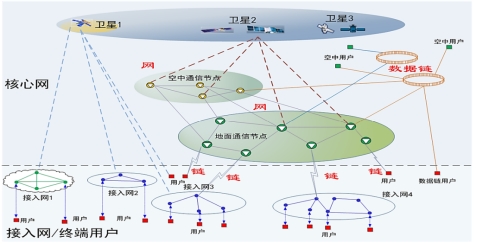Under the correct leadership and strong support of the school, the teachers of the School of Electronic Information have made joint efforts, and the output of scientific research achievements has continued to achieve good results. Now, the representative scientific research achievements in the first half of 2024 are selected and shared with everyone:
1. Paper achievement: The latest achievement of Liu Lilan and others from the communication network and testing team was published in IEEE Transactions on Wireless Communications.
Liu Lilan, Zhang Zhizhong, Zhang Haijun, Zhang Yu, Xu Yao, etc. published a paper titled "Two-Timescale Dynamic Resource Management in Smart-Grid Powered Heterogeneous Cellular Networks" in IEEE Transactions on Wireless Communications.
High energy costs and carbon neutrality goals emphasize the economy and sustainability of mobile communications. This paper studies the problem of minimizing long-term average energy trading expenditures in smart grid-powered heterogeneous cellular networks (SG-HCNs), where renewable energy is introduced. Renewable energy and wireless channel dynamics evolve on different timescales. Seek a two-timescale dynamic resource management solution in SG-HCNs, which considers the joint problems of real-time flow control, power allocation and energy sharing of renewable energy, and two-way energy trading in advance. Based on the two-tier Lyapunov framework, a two-timescale dynamic optimization (TTDO) algorithm is developed for the proposed problem. Specifically, the real-time joint problem is decomposed into two sub-problems, which are solved by linear programming and continuous convex approximation methods respectively. The approximate solution of the two-way energy trading in advance is implemented by the stochastic subgradient method, where the past data of relevant stochastic events is used as prior knowledge, which is necessary but difficult to obtain. Theoretically, the proposed TTDO algorithm can achieve asymptotic optimality and ensure queue stability. Simulation results verify the theoretical analysis and show that the proposed TTDO algorithm can obtain lower energy trading expenditures than the benchmark. In addition, the proposed TTDO algorithm shows energy-saving characteristics.

Figure 1: Schematic diagram of smart grid-powered heterogeneous cellular networks and their two-timescale resource management.
2. Paper achievement: The latest achievement of Lin Peng and others from the communication network and testing team was published in IEEE Transactions on Wireless Communications.
Lin Peng, Ning Zhaolong, Zhang Zhizhong, Liu Yan, F. Richard Yu, Victor C. M. Leung, etc. published a paper titled "Joint optimization of preference-aware caching and content migration in cost-efficient mobile edge networks" in IEEE Transactions on Wireless Communications.
The current mobile network has seen a sharp increase in wireless traffic due to the prosperity of streaming media services. Edge caching technology can greatly reduce content transmission latency, alleviate network load, and effectively enhance the quality of experience of streaming media services by sensing spatial and temporal differences in user requests and caching hot content at edge nodes. However, frequent sharing and access of content between base station nodes will consume operating costs such as bandwidth and energy consumption. Therefore, while improving service quality, the trade-off between performance and cost becomes a new challenge.
This research proposes a user-preference-aware content caching and migration scheme. In this scheme, dynamic user request preferences and long-term content migration cost budgets are considered when caching and migrating content. To reach the trade-off point between performance and cost, this research models the content caching and migration process as a long-term optimization problem. Then, the Lyapunov optimization method is used to decompose the problem into a series of real-time optimizations. Since the decomposed problem is an NP-Hard problem, an improved collective reinforcement learning (CRL) algorithm is designed in this research to achieve online efficient decision-making by training the empirical interaction between nodes. Experimental results show that the CRL algorithm has a high convergence speed, and the proposed scheme can achieve approximately optimal performance in terms of user-perceived latency, cache hit rate, and video stalling rate. Article link: https://ieeexplore.ieee.org/document/10287270.

Figure 2: Mobile network content caching and migration scenario.
3. Major model of XX instrument: Li Peng and others from the communication network and testing team successfully developed the "channel simulator" (model: NX4941).
Li Peng, Zhang Zhizhong, Feng Jiao, Zhou Hua, Qiao Jie, etc. successfully developed the major model project of the instrument - NX4941 channel simulator, which is now the only one in service. NX4941 is a general multi-channel wireless communication channel simulation solution. It is a high-performance communication instrument independently developed by Nanjing University of Information Science & Technology that can meet different test requirements such as mobile communication, wireless local area network, vehicle communication, and satellite communication. NX4941 supports up to 8 signal processing modules and a maximum of 1024 independent channels of MIMO wireless channel simulation. It widely supports various SIMO and MIMO channel models. It has rich channel models, high test flexibility, and excellent RF indicators. Especially in Doppler channel simulation (15MHz), the number of multipaths (48 standard, 90 extended), and path delay simulation, it has good performance. Some indicators are in a leading position internationally. The product innovatively adopts a modular RF front-end and signal processing unit structure, fully meeting high channel density test requirements from SISO to large-scale MIMO systems and from point-to-point communication to MESH networks.
4. XX scientific and technological breakthrough: Wang Jie and others from the radar technology team successfully developed "active detection technology based on 5G base stations".
The project successfully developed a 5G-A integrated sensing and communication base station prototype, solving key problems such as the development of a high-stability multi-channel broadband system, the modulation and demodulation of integrated communication and sensing signals under the 5G protocol framework, and the detection and stable tracking of "low, small, and slow" targets under the occlusion of strong ground clutter. It meets the strong constraints of simultaneous sensing and communication, same frequency, and same beam. The ability verification test of 5G mobile communication and complex trajectory tracking of low-altitude targets was completed in Jiangbei New District, Nanjing City, Jiangsu Province, achieving performance indicators such as a weak target sensing distance better than 1km. It supports the access of commercial 5G mobile phones, and the sensing ambiguity function is consistent with the ambiguity function of chirp signals. According to reports, this system is the third independently developed integrated sensing and communication base station prototype after Huawei and ZTE. The realized sensing resource occupancy ratio of less than 2% is an order of magnitude better than the existing level, which is expected to help 5G-A pre-research and the construction of the national low-altitude economy. The prototype covers the frequency range of 2GHz-5GHz, supports customizing signal waveforms, system parameters and processing algorithms, and has 4 transmit channels and 4 receive channels, and supports NR TDD and NR FDD formats. Relevant achievements have been reported by many media. To promote the integrated communication and sensing from theoretical exploration to engineering practice, the research group plans to open all software and hardware interfaces of the prototype to the academic and industrial communities, and provide free test and verification services for new signals and new algorithms of integrated communication and sensing.

Figure 3: 5G-A integrated sensing and communication short-range test results.

Figure 4: 5G-A integrated sensing and communication system and long-range test results (the upper right picture is the PD diagram, and the lower right picture is the track diagram).
5. XX scientific and technological breakthrough: Tu Gangyi and others from the equipment pre-research joint innovation team of the Ministry of Education were approved to develop "XXXX target collaborative positioning technology in XXXX signal distributed joint detection".
This project is oriented to the application needs of UAV prevention and control in key areas, low-altitude navigation flight control, flight route flight support, and battlefield concealed surveillance. It studies key technologies such as low-altitude target detection based on non-cooperative communication signals of the Starlink. Develop a principle prototype and carry out detection tests. Support the use of small portable Starlink receiver equipment to build a networked system to achieve all-weather early warning and surveillance of low-altitude civil aviation aircrafts, air balloons, drones and other targets, and provide technical support for key area protection, Starlink satellite reconnaissance and positioning, and the opening of low-altitude airspace.
6. Key project of Jiangsu Province's double-creation team: Zhang Zhizhong and others from the communication network and testing team were approved to develop "5G/6G and satellite communication channel simulators".
In response to the construction needs of an integrated mobile communication and satellite communication network, this project takes the mechanism research of the influence of atmospheric and geographical environments on electromagnetic signal characteristics as the starting point, gives full play to the team's technical advantages in mobile communication, meteorological inversion, environmental detection, etc., and based on the previous research on 5G channel simulators, overcome the technical difficulties of high-precision channel modeling for 6G communication and satellite communication, and establish a full-spectrum and all-scenario channel modeling theory for 5G/6G and satellite communications. Focus on solving three key scientific issues, namely, general 5G/6G non-stationary three-dimensional MIMO high-precision channel modeling, satellite communication channel modeling combined with meteorological elements, high mobility and long-distance transmission characteristics, and high-density miniaturized wideband RF transceiver technology. Build an experimental verification platform to complete key technology verification and develop a "5G/6G and satellite communication channel simulator", laying a solid theoretical foundation for my country's research and development of 5G/6G/satellite/communication channel simulators, and providing testing means for equipment development, terminal networking and network operation of future space-air-ground integrated networks.
At present, the project has completed the technical scheme demonstration, and simultaneously carried out the research on the channel modeling theory of ground and non-ground networks combined with meteorological elements, designed a baseband data board with multi-scenario, large-capacity and large-scale thread processing capabilities, and studied multi-input multi-output high-density miniaturized wideband RF technology. At present, 12 high-level papers and 16 invention patents have been completed.

Figure 5: Channel simulator architecture and double-creation team certificate.
7. National key research and development plan project: Wan Fayu and others from the radar technology team successfully developed "Key technologies for electromagnetic interference of GaN power devices for 5G communication systems".
The project established a GaN power device model and deeply studied its nonlinear mechanism. It is concluded that the main parameters affecting the linearity of GaN power devices are transconductance, source-drain saturation current, knee voltage and breakdown voltage. By optimizing the gate finger structure of the device, improve the heat dissipation capacity and reduce the self-heating effect of the device; by optimizing the barrier layer, cap layer and other structures of the device, reduce the interface trap state and thereby suppress the current collapse of the device and improve the output characteristics and linearity of the device; by designing the gate field plate to optimize the electric field on the device surface, suppress reverse leakage, and improve the breakdown voltage and output characteristics of the device. A 5G communication system test platform based on the nonlinearity of power devices is constructed, and the influence law of power amplifier nonlinearity on the performance of 5G communication systems is obtained. Through the automatic multi-frequency test system, the multi-frequency third-order intermodulation characterization of millimeter-wave power amplifier nonlinearity is innovatively proposed, and through actual multi-modulation signal and channel experiments, it is mutually verified with the 3GPP standard. Relevant results have been certified by a third party.

Figure 6: Millimeter-wave GaN power amplifier (a) IC (b) assembly (c) packaging.
8. National key research and development plan project: Xing Hongyan and others from the signal detection and instrument team successfully developed "Key technologies for intrusion detection of marine meteorological sensor networks based on deep learning".
Introduction to key research and development projects: In view of the lack of corresponding special data protection technologies and early warning mechanisms for marine meteorological observation networks, high-dimensional intrusion detection, data security guarantee and prevention and confrontation mechanisms of marine meteorological sensor networks are studied, and the intrusion detection problem of high-dimensional and massive data sensor networks is solved; a multi-dimensional connectivity probability model of high-dynamic heterogeneous marine meteorological sensor networks based on stochastic geometry is established, which solves the problem of differences in computing power and energy consumption sensitivity of nodes in marine meteorological sensor networks, and breaks through key technologies such as long-distance edge data offloading in the marine environment and the self-consistency of "cloud-edge" from shore-based offshore to far sea, which helps support the wide application of marine meteorological sensor networks and realize data protection in the information transmission of marine meteorological sensor networks and promote the implementation of the national marine strategy of "the Belt and Road Initiative".
9. Key research and development plan project of Jiangsu Province: Zhang Zhizhong and others from the communication network and testing team were approved to develop "Digital vector signal online measuring instrument".
Aiming at the problems of backward key technical indicators and imperfect functions of digital vector signal online measuring instruments based on the PXIe bus in my country, the project developed a PXIe digital vector signal online measuring instrument, carried out application demonstrations, and served the product research and development and production in fields such as next-generation wireless communication, radar, satellite, information security, automobiles, and navigation. Develop a high-density miniaturized wideband RF module with PXIe bus structure, break through high-density miniaturization of RF, and improve the frequency dynamic range and bandwidth of RF modules; develop the digital intermediate frequency module of the vector signal analysis part and the arbitrary vector signal generation part with PXIe bus structure, complete analog-to-digital/digital-to-analog conversion, digital up/down conversion, and fast Fourier transform of signals, break through high-speed DAM algorithm, multi-point FFT algorithm, etc., and improve the intermediate frequency processing speed; Based on a cross-platform development environment, develop special software for PC-side vector signal analysis, and jointly with the hardware part to realize multi-domain analysis of digital vector signals such as time domain, frequency domain, modulation domain, and generation of arbitrary vector signals. The project finally solves the problems of large frequency dynamic range and wide bandwidth small modularization, full digital intermediate frequency high-speed, and easy-to-use, smooth, and fully functional supporting host computer software. In particular, it overcomes the problem of localization of high-performance measuring instruments. The final product is tested and certified by China Telecommunication Technology Labs and completed the tests of authoritative users such as China Mobile Communications Research Institute and Huawei.

Figure 7: Digital vector signal of PXIe bus.
10. Key project of the National Natural Science Foundation of China: Pan Chengsheng and others from the intelligent network and information system team successfully developed "Traffic theory and key technologies of space-ground integrated intelligent networks".
This project constructs a "trinity" space-ground integrated intelligent network traffic theory of characteristics, boundaries and laws, solves the problem that the construction of a new generation of intelligent communication network system lacks theoretical support, and improves the real-time performance and network reorganization ability of space-ground integrated intelligent networks. On this basis, the key technology of heterogeneous link aggregation based on the space-ground integrated intelligent network traffic theory is broken through, effectively solving the problem of sharp drop in network performance caused by network congestion; the key technology of network convergence based on the space-ground integrated intelligent network traffic theory is broken through, effectively improving the network convergence and distribution efficiency. Build a space-ground integrated intelligent network traffic analysis and key technology verification system to complete key technology verification, laying a solid theoretical foundation for the construction of my country's space-ground integrated intelligent network.
At present, the project has published 18 SCI papers and produced 37 patents.

Figure 8: Space-ground integrated intelligent network architecture.

Figure 9: Space-ground integrated intelligent network traffic analysis and key technology verification system.
